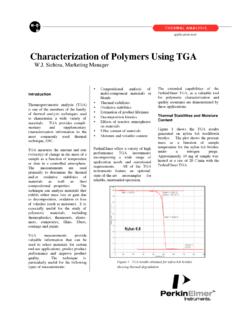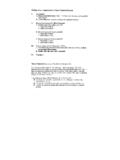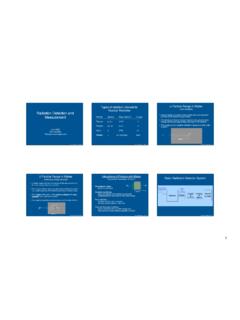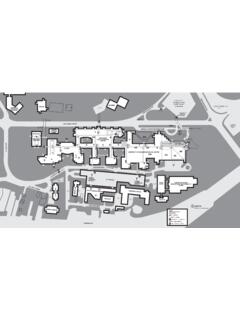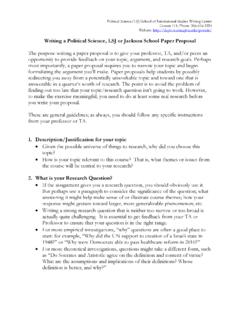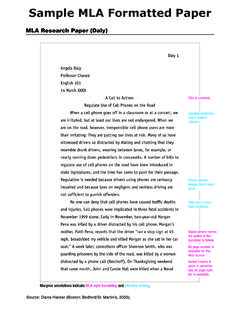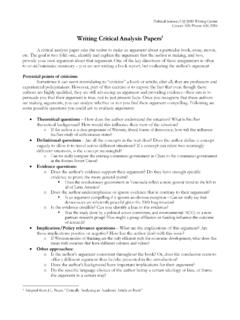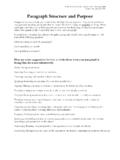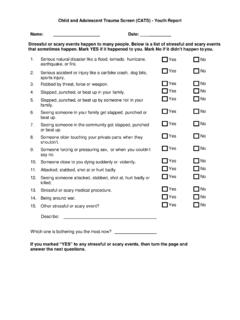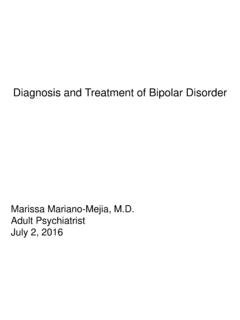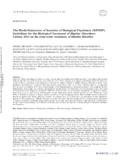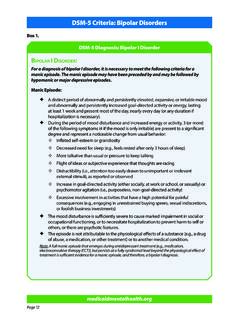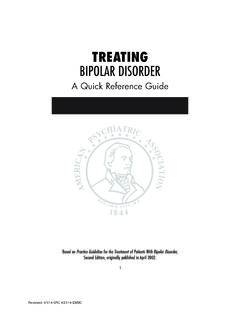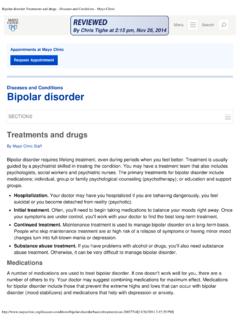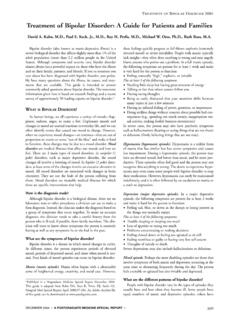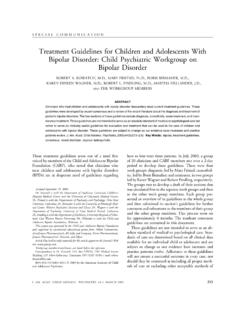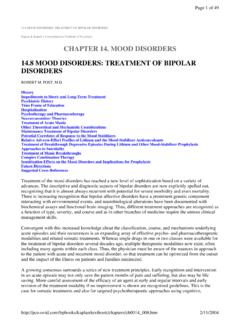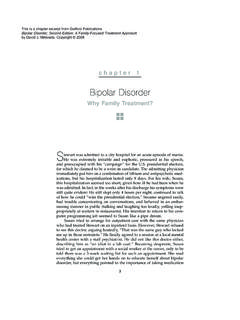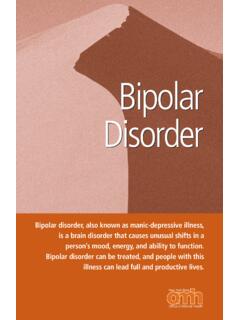Transcription of Treatment of bipolar disorder - depts.washington.edu
1 Series bipolar disorder 3. Treatment of bipolar disorder John R Geddes, David J Miklowitz Lancet 2013; 381: 1672 82 We review recent developments in the acute and long-term Treatment of bipolar disorder and identify promising See Comment page 1599 future routes to therapeutic innovation. Overall, advances in drug Treatment remain quite modest. Antipsychotic This is the third in a Series of drugs are e ective in the acute Treatment of mania; their e cacy in the Treatment of depression is variable with the three papers about bipolar clearest evidence for quetiapine. Despite their widespread use, considerable uncertainty and controversy remains disorder about the use of antidepressant drugs in the management of depressive episodes. Lithium has the strongest evidence Department of Psychiatry, for long-term relapse prevention; the evidence for anticonvulsants such as divalproex and lamotrigine is less robust University of Oxford, Oxford, UK (Prof J R Geddes MD, and there is much uncertainty about the longer term bene ts of antipsychotics.)
2 Substantial progress has been made Prof D J Miklowitz PhD); and in the development and assessment of adjunctive psychosocial interventions. Long-term maintenance and possibly Division of Child and acute stabilisation of depression can be enhanced by the combination of psychosocial treatments with drugs. The Adolescent Psychiatry, development of future treatments should consider both the neurobiological and psychosocial mechanisms underlying University of California, Los Angeles (UCLA) School of the disorder . We should continue to repurpose treatments and to recognise the role of serendipity. We should also Medicine, Los Angeles, CA, USA investigate optimum combinations of pharmacological and psychotherapeutic treatments at di erent stages of the (Prof D J Miklowitz PhD) illness. Clari cation of the mechanisms by which di erent treatments a ect sleep and circadian rhythms and their Correspondence to: relation with daily mood uctuations is likely to help with the Treatment selection for individual patients.
3 To be Prof John Geddes, Department of economically viable, existing psychotherapy protocols need to be made briefer and more e cient for improved Psychiatry, University of Oxford, Warneford Hospital , Oxford scalability and sustainability in widespread implementation. OX3 7JX, UK. Introduction in diagnosis and neurobiology are beyond the scope of bipolar disorders types I and II a ect about 2% of the this review and are mentioned only when they have direct world's population, with subthreshold forms of the implications for management. Despite a substantial disorder a ecting another 2%.1 2 Even with Treatment , expansion of research into bipolar disorder and potential about 37% of patients relapse into depression or mania treatments during the past 2 decades, true advances have within 1 year, and 60% within 2 In the STEP- been few. The development of e ective treatments for BD cohort (n=1469), 58% of patients with bi- bipolar disorder is hampered by our scarce knowledge of polar disorder types I and II achieved recovery, but 49% basic disease mechanisms and the consequent absence of had recurrences in a 2-year interval; twice as many of validated pharmacological targets, and unconvincing these recurrences were of depressive polarity (marked by animal or human experimental drug models (table 1.))
4 Sad mood, loss of interests, or fatigue) rather than of provides a summary of putative Treatment targets). Most manic polarity (marked by elevated mood, grandiosity, newly introduced treatments for bipolar disorder , whether and decreased need of sleep).4 After initial onset, patients pharmacological or psychological, have been based on an with bipolar disorder have residual depressive symptoms extension of use from another disorder eg, antipsychotics for about a third of the weeks of their In 2009, the in mania and antidepressants or cognitive-behavioural direct and indirect costs of bipolar disorder were esti- therapy for bipolar depression. However, lithium remains mated to be US$151 Patients also experience unique because its main therapeutic use is in bipolar psychotic symptoms, impaired functioning, compro- disorder , and investigation of its mechanism of action has, mised quality of life, and ,8 and remains, crucially important in the identi cation of Treatment of bipolar disorder conventionally focuses future targets.
5 On acute stabilisation, in which the goal is to bring a patient with mania or depression to a symptomatic Treatment of mania recovery with euthymic (stable) mood; and on mainten- The pioneering trials of lithium and chlorpromazine were ance, in which the goals are relapse prevention, done in the 1970s and were followed by a focus on reduction of subthreshold symptoms, and enhanced antiepileptics (eg, valproate and carbamazepine) in the social and occupational functioning. Treatment of both 1980s and 1990s. Few trials directly assessing the compara- phases of the illness can be complex, because the same tive e cacy of di erent second-generation antipsychotics treatments that alleviate depression can cause mania, exist, but a mixed treatments meta-analysis compared hypomania, or rapid cycling (de ned as four or more 13 agents studied in 68 randomised controlled trials episodes in 12 months), and the treatments that reduce (16 073 participants).9 This review found substantial and mania might cause rebound depressive episodes.
6 Clinically important di erences in terms of both e cacy We focus on contemporary issues in the acute and and tolerability between agents. Antipsychotic drugs seem maintenance Treatment of bipolar disorder . Developments to be better than anticonvulsants and lithium in the 1672 Vol 381 May 11, 2013. Series Evidence of target validation Neurotransmitter and neurohormonal dysregulation Dopamine9,10 Antipsychotic agents block dopamine D2 receptors and are potent antimanics Serotonin11 Selective serotonin reuptake inhibitors of uncertain e cacy, atypical antipsychotics enhance serotonin activity Glutamate12 14 Valproate, lamotrigine, and some antidepressants modulate glutamate transmission; rapid alleviation of depressive symptoms with ketamine infusion Intracellular signalling Inositol monophosphatase15,16 Lithium, valproate, and carbamazepine reduce intracellular myoinositol concentration and increase neuronal growth cone spreading at therapeutic concentrations GSK-314,17 Neuroprotective e ects of lithium and other agents might be mediated by inhibition of GSK-3.
7 Protein kinase C pathway18 Lithium and valproate inhibit PKC activity; tamoxifen inhibits PKC activity and might be antimanic Calcium channels17 CACNA1C risk allele associated with bipolar disorder ; lamotrigine inhibits voltage-activated calcium channels;. calcium channel blockers might be antimanic Neural mechanisms Corticolimbic emotion control circuit19 Hyperactivation of amygdala and reduced anterior cingulate activity during mania; reduced ventrolateral prefrontal cortex activity and hyperactivation of basal ganglia across mood states; reduced resting state connectivity of amygdala and prefrontal regions Sleep and circadian regulation Circadian clock associated with impaired Antipsychotics, lithium, and valproate regulate sleep and circadian rhythms and stabilise mood; interpersonal and sleep and weight changes20 22 social rhythm therapy is associated with delayed recurrences when social and circadian rhythms are regulated Psychosocial variables Responses to stressful events23,24 Negative events are associated with depressive episodes; goal attainment events are associated with manic episodes.
8 Psychosocial treatments can modulate responses to stress High expressed emotion and negative Crucial attitudes in caregivers and negative verbal interactions between caregivers and patients associated with family interactions23,25,26 greater likelihood of recurrence; family-focused therapy enhances family communication and is associated with reduction in mood symptoms Drug adherence27 29 Psychoeducational treatments improve adherence to mood stabilisers, leading to lower likelihood of manic recurrence Table 1: Validation evidence of putative Treatment development targets in bipolar disorder Treatment of manic episodes. Olanzapine, risperidone, and associated with the addition of paroxetine or bupropion to haloperidol seem to have the best pro le of presently a mood stabiliser;33 another reported that paroxetine was available agents ( gure).9 Therefore, antipsychotic agents no better at achieving a durable recovery than will often be the appropriate short-term clinical Treatment , A recent updated meta-analysis of antidepressants in although a drug with better long-term evidence of e cacy bipolar depression reported a pooled e ect no di erent such as lithium might be preferred when continued drug from placebo (relative risk [RR] of response 1 17, 95% CI.)
9 Therapy is planned. 0 82 1 57) with statistically signi cant Meta-analyses in patients with bipolar disorder have Treatment of bipolar depression grouped antidepressant drugs together as one class, The Treatment of bipolar depression is a major challenge, despite the observed statistically signi cant hetero- with few treatments of proven e cacy and, in particular, geneity and the evidence in patients with unipolar substantial controversy about the role of antidepressant disorder that antidepressant agents vary to a clinically drugs. Authors of guidelines and consensus statements signi cant degree in both e cacy and on this topic often ponder why antidepressants are so Therefore, to conclude that no antidepressant agent is commonly used despite the scarce evidence for e 32 e ective in bipolar depression is probably premature, Until recently, after the work of Emil Kraepelin, bipolar although the emerging evidence suggests that paroxe- depressive episodes were deemed phenomenologically tine is ine ective.
10 And biologically similar to unipolar depressive episodes. The antiepileptic drug lamotrigine was investigated in Even as late as the 1990s, inclusion and exclusion criteria patients with bipolar depression after a clinical bene t in clinical trials of antidepressants in patients with was seen after Treatment with the drug in patients with depressive disorder did not usually either select or stratify bipolar A meta-analysis of individual patient- according to polarity. Earlier trials suggested that when level data from ve trials of lamotrigine in bipolar given with antimanic Treatment , selective serotonin depression reported a modest Treatment e ect; however, reuptake inhibitor antidepressants were more e ective no one trial showed statistically signi cant bene ts of and no more likely to induce mania than placebo, and Treatment with lamotrigine in comparison with placebo. were less likely to induce mania than tricyclic anti- Thus, the place of lamotrigine in acute Treatment In 2007, a large trial found no bene t remains Vol 381 May 11, 2013 1673.
